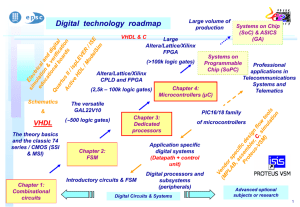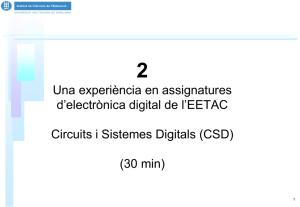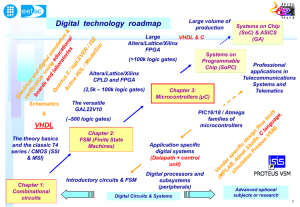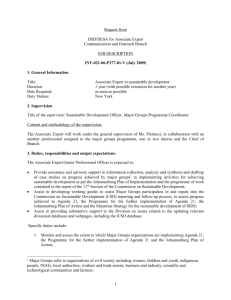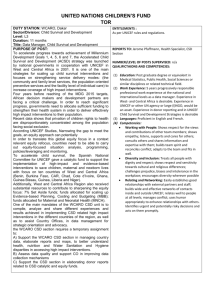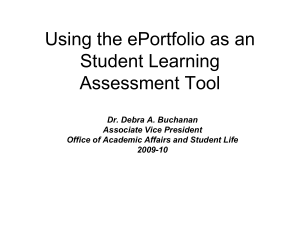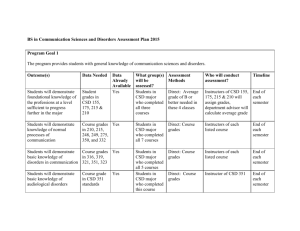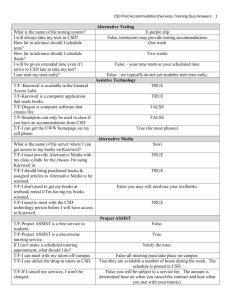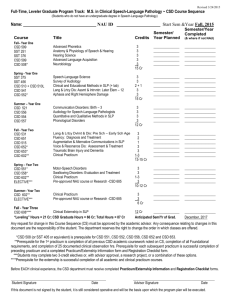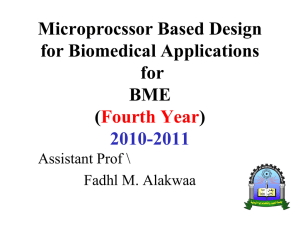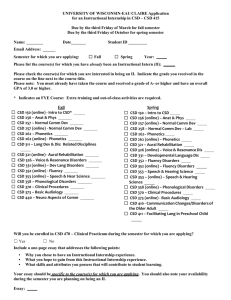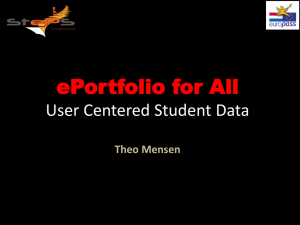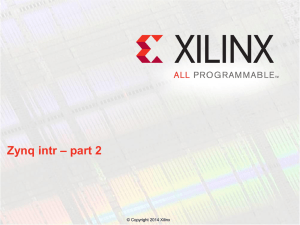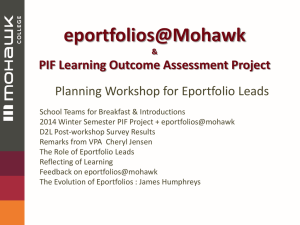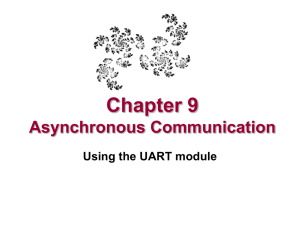course presentation slides - CSD
advertisement
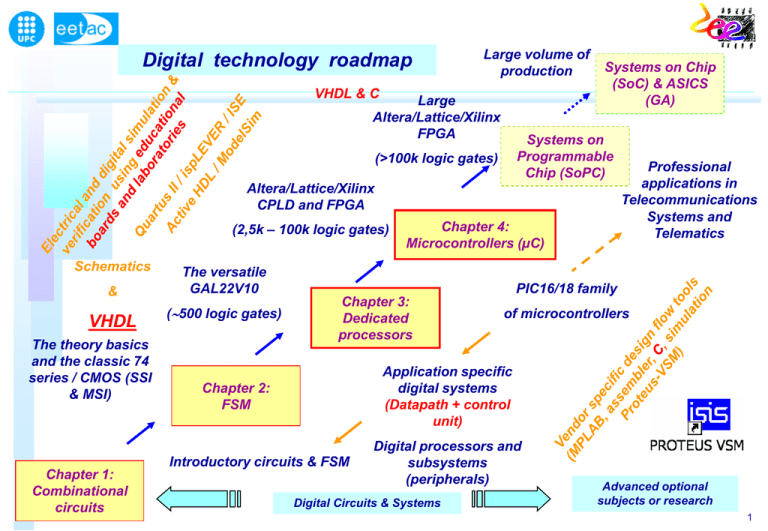
Digital technology roadmap Large volume of production VHDL & C Large Altera/Lattice/Xilinx FPGA Systems on Chip (SoC) & ASICS (GA) Systems on Programmable Chip (SoPC) (>100k logic gates) Altera/Lattice/Xilinx CPLD and FPGA (2,5k – 100k logic gates) Schematics & VHDL The theory basics and the classic 74 series / CMOS (SSI & MSI) The versatile GAL22V10 (500 logic gates) PIC16/18 family Chapter 3: Dedicated processors of microcontrollers Application specific digital systems (Datapath + control unit) Chapter 2: FSM Introductory circuits & FSM Chapter 1: Combinational circuits Chapter 4: Microcontrollers (µC) Professional applications in Telecommunications Systems and Telematics Digital processors and subsystems (peripherals) Digital Circuits & Systems Advanced optional subjects or research 1 CSD competencies Programmable logic devices and VHDL Microcontrollers English Self-directed learning Oral and written communication Project management Team work Lab skills (Systematically design, analyse, simulate, implement, measure, report, present, publish on the web and reflect about … digital circuits and systems using state-of-the-art digital programmable devices, CAD/EDA software tools and laboratory equipment And show all your achievements constructing your ePortfolio 2 CSD systematic instructional design Learning objectives and cross-curricular skills After completing the course students have to be able to … Repeated every term Course evaluation Student questionnaires, and instructors processing Coherence and consistency Continuous formative and summative assessment Activities and study time scheduling In and out of class timetable, problembased learning, application project Systematic procedures for solving assignments (plan, develop, simulate, prototype, measure, report) Active methodologies Individual and group assessing, every work sample counts and can be improved, group e-portfolio No need of traditional exams Cooperative Learning, integrated learning of content and cross-curricular skills, Learning by doing 3 Learning objectives Chapter 1 Combinational circuits Chapter 2 Finite state machines Chapter 3 Digital processor Chapter 4 Microcontrollers #6, #7, #8, #10 #9, #10, #11 #10, #12 #13, #14, #15 Cross-curricular objectives: #1, #2, #3, #4, #5 http://epsc.upc.edu/projectes/ed/CSD/index_CSD.html 4 CSD specific content Chapter 1 Chapter 2 Chapter 3 Chapter 4 Combinational circuits Finite state machines Digital processor Microcontrollers (FSM) (Datapath + control unit) (C) (23h) – 0.92 ECTS (23h) – 0.92 ECTS (69h) – 2.76 ECTS (35 h) – 1.4 ECTS Laboratory skills: signal generators, oscilloscopes, logic analysers, debuggers/programmers, etc. … •Proteus-ISIS (Labcenter) •Quartus II (Altera) •Proteus-VSM (Labcenter) •Minilog, IC prog •ispLEVER Starter or Classic (Lattice Semiconductor) •MPLAB (Microchip) •WolframAlpha •ISE (Xilinx) •HI-TECH C Compiler for PIC10/12/16 MCUs (Lite mode) (Microchip) • Programmable logic devices (CPLD and FPGA) from Altera, Lattice, Xilinx • PIC 16F/18F family of microcontrollers •Training boards (UP2, DE2, Spartan 3AN Starter Kit, MachXO USB Starter Kit, NEXYS 2, etc. • Training boards PICDEM2+, etc. •VHDL •ModelSim (Mentor Graphics), Active HDL (Aldec) •ISim (Xilinx) •Synplicity Synplify synthesis (Synopsys) • Altera Integrated Synthesis • XST (Xilinx Synthesis tools) •Classic IC’s • sPLD GAL22V10 •ispLEVER Classic 5 CSD generic tools Oral and written communication English Self-directed learning Team work Project management •Microsoft Office • Google docs • Visio 2010 • Google sites •Thunderbird • Web editing tools •CMapTools • Proofing tools •Gantt diagrams • Google translate • etc. 6 Planning activities and study time in and out of the classroom (6 ECTS – 150 h) Weekly study plan Activities (~problem solving all the time) Application project Guided learning Exercises (EX1 .. EX4) Individual test Problem solving teamwork session at classroom (2 h) Problem solving teamwork session at classroom / laboratory (1 h)* Problem solving teamwork session at laboratory (2 h) 13 weeks 11.5 h per week (IT1 .. IT4) Self-directed learning ePortfolio Student-conducted teamwork sessions 6 ECTS (>6h) Extra individual work * Guided academic activities 7 Exercises and calendar on the CSD web 8 The CSD Blog http://digsys.upc.es/wp/wordpress/ 9 Activities Design of real world applications Design using PLD/VHDL Design using microcontrollers 10 The content on the CSD web (units) is focused on problem solving 11 Course timetable EX : exercise/problem AP: project A : assessment eP: e-portfolio IM: improvement IT: Individual unannounced test 12 Cooperative Learning as the instructional method • Positive interdependence Team members are obliged to rely on one another to achieve their common goal • Individual accountability All students in a group are held accountable for doing their share of the work and for mastery of all of the content to be learned • Face-to-face promotive interaction Group members providing one another with feedback, challenging one another’s conclusions and reasoning, and teaching and encouraging one another • Appropriate use of collaborative skills Students are encouraged and helped to develop and practice skills in communication, leadership, decision-making, conflict management, and other aspects of effective teamwork • Regular self-assessment of group functioning Team members periodically assess what they are doing well as a team and what 13 they need to work on for functioning more effectively in the future A typical 2-hour group work session Up to 15 minutes Questions from previous sessions or exercises Up to 15 minutes Introduction of new concepts or materials (generally, the problem to be designed) 30 minutes Group work for revising concepts and planning exercises Up to 15 minutes Questions, discussion and general orientations 30 minutes Group work for developing exercises 15 minutes Conclusions and planning for the studentdirected sessions outside the classroom 14 Cooperative group ePortfolio and instructor’s feedback A semi structured group e-portfolio organised to show your learning process and results 15 Showcase ePortfolio An ePortfolio organised according the subject’s cross-curricular skills to show your achievements (http://electronicportfolios.com/balance) Table of contents 1. Course, purpose, audience and structure 2. A list of hardware/software tools and laboratory equipment and examples on the way you’ve been using them 3. Work samples and reflection for the cross-curricular skills 1. 3rd language (English) 1. An active reading of a paper or a book unit 2. A written assignment in English 3. Exam solution 2. Team work 1. Learning an electronic design automation (EDA) tool in group 2. An example of a group assignment 3. Oral and written communication 1. A concept prepared to learn the design flow for a digital circuit 2. A peer-reviewed written assignment 3. An oral presentation in class 4. Self-directed learning/project management 1. Example of a project organisation and development 2. Example of a unit or lesson studied autonomously . General reflection and conclusions An excellent way for showing evidence of what you’ve learnt 16 Student assessment Assessment is not a mechanism for verifying student knowledge, but an stimulus to guarantee that (motivated) students will do the group tasks which lead them to learn the content and skills Assessment is another learning activity integrated in the course dynamics ePortfolio Every piece of work counts for the final grade • Final exams are no longer needed 17 Assessment scheme Rubrics and examples from previous terms, facilitates assessing and giving fast feedback Exercises + Includes an oral presentation and a written report Individual test + 6 deliverables with optional improvement Examples to demonstrate content learning, crosscurricular skills development and reflection Application Project + 4 individual “unannounced” exams e-Portfolio + Participation Oral: 12.5% Written doc: 7.5% Ep1: Week 9, 5% and attitude Ep2: Week 14 , 10% Q EX 30 % IT 25 % AP 20 % eP 15 % P & A 10 % Continuous assessment: you’ll always know where you are and what you have to do to improve 18 Assessment scheme A remark on the Exercises assessment: There is a link between the IT and the EX: Exercises (30%) Individual Test (25%) EX1A , EX1B, EX1C IT1 EX2 IT2 EX3 IT3 EX4 IT4 The EX will have a preliminary group grade. In order to get its final grade, students have to pass the corresponding IT. If a given student fail its IT, its EX will be graded with a “4”. At week 9 there will be another opportunity to pass or improve IT1 and IT2. IT3 and 4 can be assessed again at week 14. 19 Course evaluation and processing This quality cycle has to be repeated every term CSD WEB page Course evaluation Student questionnaires, and instructors processing Learning objectives and cross-curricular skills Coherence and consistency Continuous formative and summative assessment Activities and study time scheduling Active methodologies The evaluation’s aim is to prepare a plan with specific actions to improve teaching in upcoming courses (problems redesigning, timetable scheduling, workload, teaching materials, new software, demonstration exercises, etc.) 20
